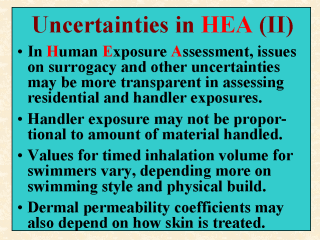 |
The concerns on
the use of transfer rate and foliar residues in the last slide may not be transparent to
those less familiar with reentry exposure assessment. The following discussions on
residential and agricultural handler exposures may be more appreciable. As stated in Lecture 8, Pesticide Handlers Exposure Database
(PHED, 1995) and European Predictive Operator Exposure Model (EUROPOEM, 1996) are
used to provide surrogate exposure rates based on the assertion that handler exposure is
proportional to the amount of material handled. Yet a large amount of material used in a
day's work can be handled in many ways, depending on how the product is packaged and what
type of mixing/loading/application equipment is used. Workers apparently would be exposed
to more pesticide residues directly if they are required to mix and load 200 10-lb
bags, than four 500-lb bags (of the product) per day. A revisit of the first two
case studies in Lecture 8 also illustrates similar
problems with residential exposures. Values for respiration rate are required to estimate
inhalation exposure for persons swimming in pools treated with water disinfectants. Both
the swimming style and the physiological as well as physical build of the swimmer can have
a great impact on these values. In addition, as asserted in USEPA's swimmer exposure model
(Dang, 1996), dermal exposure for swimmers is a function of skin permeability coefficient.
Yet there does not seem to be adequate data supporting the assumption that the
chemical-specific permeability coefficient is about the same for the skin submerged in a
solution, as for the skin moving in a big solution tank. |
